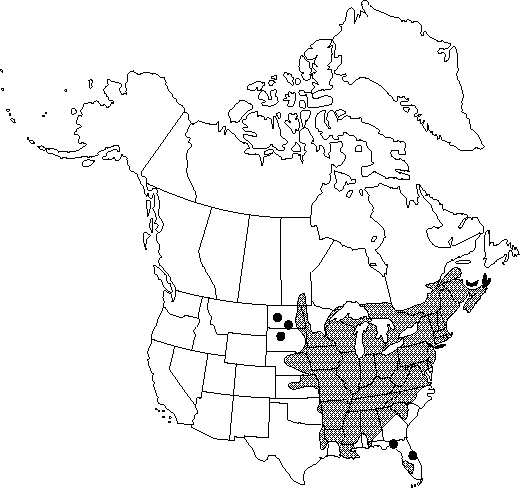Clematis virginiana
Cent. Pl. I, 15. 1755.
Stems climbing, 2-7 m. Leaf blade 3-foliolate; leaflets ovate to lanceolate, 3.5-9 × 1.5-7.5 cm, margins coarsely toothed to entire; surfaces abaxially sparsely to densely pilose, adaxially glabrate. Inflorescences axillary, 3-many-flowered simple or compound cymes. Flowers unisexual; pedicel slender, 1-2 cm; sepals wide-spreading, not recurved, white to cream, elliptic or nearly oblong to oblanceolate, 6-14 mm, abaxially densely white-hairy, adaxially sparsely white-hairy; stamens ca. 30-50+; filaments glabrous; staminodes absent or fewer than stamens; pistils 40-70; beak nearly equaling sepals. Achenes ovate, 2.5-3.5 × l.5 mm, conspicously rimmed, sparsely short-hairy; beak 2.5-5 cm. 2n = 16.
Phenology: Flowering summer (Jun–Sep).
Habitat: Streamsides, wet roadsides, fencerows, and other moist, disturbed, wooded or open sites, locally abundant
Elevation: 0-1500 m
Distribution

Man., N.B., N.S., Ont., P.E.I., Que., Ala., Ark., Conn., Del., Fla., Ga., Ill., Ind., Iowa, Kans., Ky., La., Maine, Md., Mass., Mich., Minn., Miss., Mo., Nebr., N.H., N.J., N.Y., N.C., N.Dak., Ohio, Okla., Pa., R.I., S.C., S.Dak., Tenn., Tex., Vt., Va., W.Va., Wis.
Discussion
Clematis virginiana is the most frequent and widespread virgin's-bower in eastern North America. It is easily distinguished from C. catesbyana by the presence of three ovate leaflets.
Native Americans used infusions prepared from the roots of Clematis virginiana medicinally to treat kidney ailments, and mixed them with milkweed to heal backaches and venereal sores. Decoctions of stems were ingested to induce strange dreams. In addition, the plant was used as an ingredient in green corn medicine (D. E. Moerman 1986).
Selected References
None.